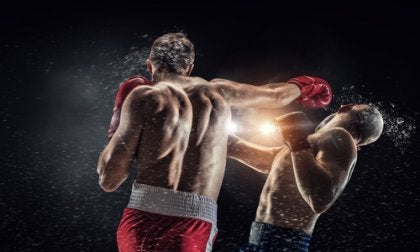Dementia Pugilistica or "Boxer's Dementia"

Dementia pugilistica is a neurodegenerative disorder. It has received attention in recent years as researchers discover more about the repercussions of playing certain sports. Its other name, “boxer’s dementia”, gives you a clue about its etiology. The Latin root word, pugil refers to boxing. The repeated blows to the head during a boxer’s career are often what cause this kind of dementia.
While it would be hard to calculate exactly how many times a contact-sport athlete gets hit in the head during their career, it’s not hard to imagine that these repeated blows have repercussions.
Multi-trauma and repeated concussions lead to cortical atrophy of the brain, which causes dementia pugilistica.

General characteristics of dementia pugilistica
In 1928, pathologist and medical forensic scientist Harrison Martland was the first to describe clinical dementia pugilistica.
Today, scientists categorize it as a variant of chronic traumatic encephalopathy. In the beginning, however, there was no differentiation between the two. Researchers noticed the distinction when they realized that they only saw symptoms of dementia pugilistica in certain groups.
A silent disease
Boxing’s popularity at the beginning of the 20th century inspired many professionals and fans to get involved in the sport. In the beginning, the consequences went unnoticed. Over the years, however, the number of cases of people with symptoms started to rise.
The most common symptoms were apathy, psychotic traits, loss of coordination, and marked global intellectual impairment. Scientists made the connection between these symptoms and repeated micro-injuries to the brain caused by concussions.
Developing dementia pugilistica
Cortical atrophy of the brain leads to a general reduction in brain size. It also slows down its metabolism. In general, cortical atrophy affects all brain structures which negatively affects overall functionality.
This illness is progressive and the symptoms can vary:
- Early-stage. The patient experiences the first symptoms of cognitive impairment from multi-trauma to the head. Although there’s no clear “start date” of the disease, it tends to be latent in the first years.
- Advanced stage. Experts believe that the advanced stage usually begins about 12 to 16 years after the patient takes up the sport. By this time, symptoms are obvious but they can’t yet be categorized as dementia.
- Dementia. Symptoms are established and affect all aspects of the patient’s functionality. Loss of mental faculties such as memory and reasoning become evident and significantly affect behavior.
Main symptoms
The symptoms of dementia pugilistica vary, which is why it’s easy to mistake them for those of other neurodegenerative diseases. Nevertheless, dementia pugilistica patients tend to share a group of patients, which become more pronounced with time:
- General apathy. Lack of emotional expression or interest, accented by an impairment in communication ability.
- Aggressiveness. Physical and verbal aggressiveness; patients become impulsive and irritable.
- Depression. The progressive nature of the symptoms tends to lead to loss of motivation, isolation, and despair.
- Memory. Patients have the most trouble with day-to-day tasks. Changes in memory correlate to problems paying attention and focusing.
- Motor problems. At first, patients just seem a little clumsy or careless. Over time, however, they become slow, stiff, and uncoordinated.
Primary risk factors for dementia pugilistica
The main risk factor for developing this kind of dementia is participating in contact sports. Thus, in spite of the name, boxing isn’t the only sport that can cause it. Here are other sports that put athletes at risk:
- American football.
- Kickboxing.
- High contact sports.
- Motorized racing sports.
Other risk factors also include:
- Starting a contact sport at a young age.
- Not using the protective gear that experts recommend for the sport.
- A long-running athletic career.
- Not practicing prevention strategies.
Diagnosis
Dementia pugilistica doesn’t involve one specific injury or area of the brain. Consequently, it’s difficult to diagnose.
A neurologist and a neuropsychologist usually evaluate the patient for their behavioral and motor symptoms. Doctors also use neuroimaging (such as CT scans) to determine the degree of brain damage.

Treatment
The primary treatment for dementia pugilistica involves avoiding the risk factors. If you practice one of the above sports, you should take every possible measure to protect yourself and be cautious.
If a patient already has symptoms, there are two common approaches:
- Medicalization. Treatment with pharmaceutical drugs that address specific symptoms.
- Rehabilitation. The patient should start treatment as soon as possible to take advantage of the brain’s plasticity. Therapists usually focus on teaching the patient ways to compensate for their loss of motor abilities. The goal is that they continue to function as normally as possible.
Some things to consider
Dementia pugilistica is a very clear example of what happens when you don’t take care of your brain. The changes show up over the long-term, but the causes happen early in life.
The lack of immediate consequences makes it difficult to be fully aware of the damage. However, any activity that corrodes the nervous system will take a serious toll on your body over time. Eating well is a very important preventative method for any type of dementia.
Lastly, it’s important to remember that some very popular sports aren’t necessarily healthy. That’s especially true if you don’t take the proper precautions. A large percentage of former American football players have traumatic brain injuries. Their athletic careers will negatively affect them for the rest of their lives.
In conclusion, thanks to new studies and increased awareness of the risks, the athletic community is taking measures such as providing compensation for former players and investing more money in research.
“Trust in the great American ingenuity. We can derive more intelligent, more brain-friendly ways we can play football.”
-Dr. Bennet Omalu-
All cited sources were thoroughly reviewed by our team to ensure their quality, reliability, currency, and validity. The bibliography of this article was considered reliable and of academic or scientific accuracy.
- Álvarez Cambras, Rodrigo. Lesiones Traumáticas del Deporte. Revisión de los casos tratados en el Dpto. de Traumatología del Deporte del Hospital Ortopédico “Frank País”. 1er Congreso Internacional de Medicina del Deporte.
- Álvarez Cambras, Rodrigo y col (1977) Síndrome de impactación del carpo (técnica quirúrgica del autor), Revista Cubana de cirugía, 16 (6): 583-99.
This text is provided for informational purposes only and does not replace consultation with a professional. If in doubt, consult your specialist.








